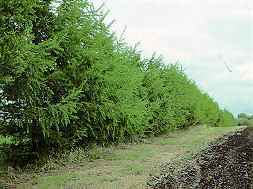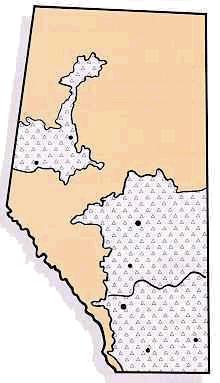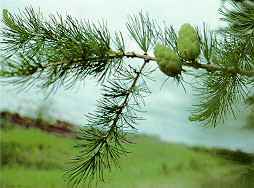| | Plant characteristics | Fall colour | Site preference | Hardiness | Uses | Problems | Diseases | Insects | Pruning
.

Scientific Name: Larix sibirica Ledeb.
Plant Characteristics
This tree is native to eastern Russia, Siberia and Northern China.
It is a medium to tall size deciduous tree, with a straight, gradually tapering trunk and narrow open crown of many irregularly arranged, slender somewhat horizontal branches.
Larch can reach a height of 15 to 20 m (50 to 65 ft), with a spread of up to 7.5 m (25 ft).
It can live up to 100 years with a growth rate of up to 20 to 150 cm (8 to 60 in.) a year.
Leaves - The leaves (needles) appear on the trees in two different kinds of twigs. Towards the ends of the branches and branchlets, the twigs elongate in the regular way and they bear single leaves distinctly separated from each other. Further back on branches, many of the leaves crowd so closely that they appear to be in clusters.
The leaves of the larch are spirally arranged, needle-shaped, slender, flexible and soft to touch, 20 mm to 45 mm (0.75 to 1.75 in.) long, the numbers in the cluster vary from 10 to 50. They differ from all other conifers in not retaining their foliage over the winter.
Cones - Short and roun. Borne on the dwarf twigs, stand erect on short stalks and open when mature to release the winged seeds. Cones are formed and mature in one season. Cones are brown.
Bark - Scaly, resembling that of a spruce tree, but the inner bark of larch is a vivid reddish purple.
Fall Colour
Needles turn yellow in fall before dropping off.
Site Preference
It is found on a wide range of soil textures. It grows best on moist, light, well-drained soils, and is adaptable to dry conditions.
Fair tolerance to drought.
Has very low shade tolerance; it requires well lighted situations and is rarely found in pure stands.
Not generally found on saline soils, but has a high tolerance to acid soils.
Hardiness
Larch is fully winter hardy.
.


Uses
Rodents will eat young plants and seed may be eaten by birds and small mammals. Larch makes a good field windbreak because it loses its foliage during the winter. The wide - spreading branches make this species very suitable for accent plantings, particularly because of its foliage colour in fall. For field windbreaks it can be planted 2 to 4 m(6 to 13 ft) between trees in a row.
Problems
Can be difficult to start or to transplant. Survival has been much greater since trees have become available as container grown stock.
Diseases
Susceptible to needle cast, needle rusts, "Amillaria root rot" and white pocket rot.
Insects
Larch sawfly can defoliate the trees.
Pruning
Pruning is not required, unless there is a double leader, then one must be removed. If there is no leader, a new leader must be trained.
.

Shelterbelts Varieties for Alberta provides information on a number of other trees and shrubs than may be suitable for shelterbelts.
Visit our website directory for the Reforestation Woodlot Listings. |
|